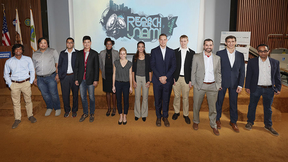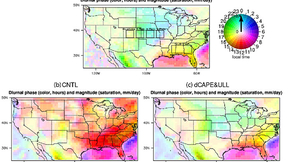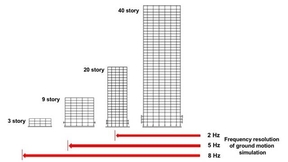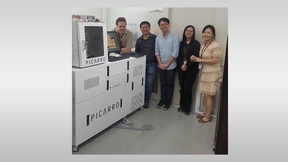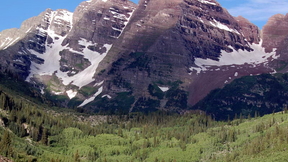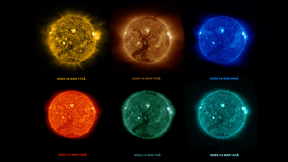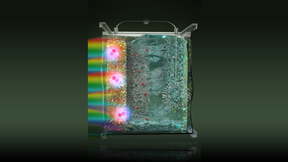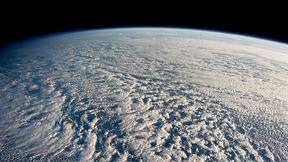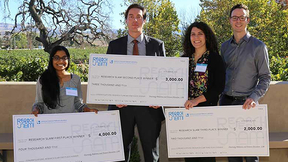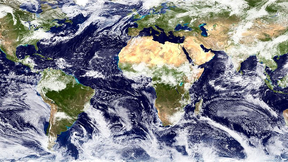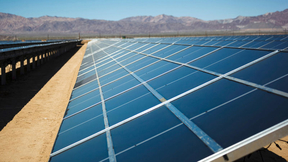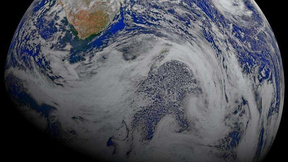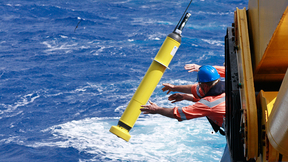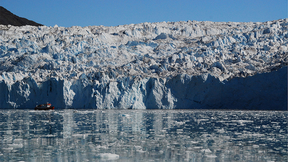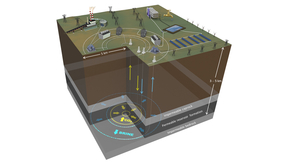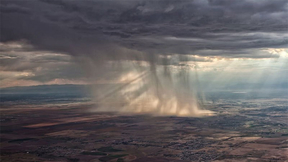Back
Earth and Atmospheric Science
3D-printed aerogel electrodes boost energy storage
A team of Lawrence Livermore National Laboratory (LLNL) scientists and collaborators from the University of California, Santa Cruz (UCSC) and Sun Yat-Sen University have developed a new class of aerogel electrodes with a simultaneous boost in energy and power density. The research could be a boon for the energy storage industry. “This is the first example in which we were…
PLS postdocs shine at Research Slam! competition
On October 29, 2019, twelve Lawrence Livermore postdocs took to the stage, each with three slides and three minutes to answer the question: “Why is your research important?” The presentations, part of a yearly competition known as the Research Slam!, were a culmination of months of development, training, and practice. The 2019 program kicked off with seminars about…
More accurate modeling of precipitation’s diurnal cycle
Precipitation is one of the most challenging aspects of climate to model, so the accuracy with which it is represented is therefore frequently cited as a barometer for the quality of climate forecasting. A shortcoming in current climate models is their inability to accurately predict diurnal precipitation patterns. Over land, the daily precipitation cycle is strong: As the…
Bioprinting of live cells enhances catalytic efficiency
Critical to the success of high-performance, three-dimensional (3D) printed living materials is the development of new ink materials and 3D geometries that favor long-term cell functionality. To address this challenge, a cross-directorate LLNL team, collaborating with National Renewable Energy Laboratory researchers, has invented a new bio-ink system using viable freeze…
Using supercomputers to quantify Bay Area earthquake hazard and risk
With unprecedented resolution, Lawrence Livermore and Lawrence Berkeley national laboratory scientists and engineers are simulating precisely how a large-magnitude earthquake along the Hayward Fault would affect different locations and buildings across the San Francisco Bay Area. The researchers reported on their recent simulations in June at the U.S. National Conference…
Human influence detected in changing seasons
For the first time, scientists from Lawrence Livermore National Laboratory (LLNL) and five other organizations have shown that human influences significantly impact the size of the seasonal cycle of temperature in the lowest layer of the atmosphere. To demonstrate this, they applied a so-called "fingerprint" technique. Fingerprinting seeks to separate human and natural…
Prototype cavity ring-down spectroscopy instrument for 14C measurements
A commercial cavity ring-down spectroscopy (CRDS) instrument for the measurement of 14C in biological studies has been developed through a Cooperative Research and Development Agreement between Picarro, Inc. and Lawrence Livermore National Laboratory—where much of the initial research and development was performed. CRDS is a highly sensitive optical spectroscopic technique…
Study on impact of climate change on snowpack
An international team of scientists, including one from Lawrence Livermore National Laboratory (LLNL), has found that up to 20 percent loss in the annual maximum amount of water contained in the Western United States’ mountain snowpack in the last three decades is due to human influence. Peak runoff in streams and rivers of the Western U.S. is strongly influenced by…
Here comes the sun in first-time images
The first images from the Solar Ultraviolet Imager (SUVI) instrument aboard the National Oceanic and Atmospheric Administration’s GOES-16 satellite capture a large coronal hole on the sun. The Geostationary Operational Environmental Satellites (GOES) are part of NOAA’s space weather monitoring fleet. GOES-16 launched late last year. GOES-16 (known as "GOES-R" before its…
Carbon-free energy from solar water splitting
A Lawrence Livermore National Laboratory (LLNL) scientist and collaborators are fine tuning the mechanisms to generate hydrogen from water and sunlight. Hydrogen production offers a promising approach for producing scalable and sustainable carbon-free energy. The key to a successful solar-to-fuel technology is the design of efficient, long-lasting and low-cost…
Cloudy feedback on global warming
Lawrence Livermore National Laboratory researchers have identified a mechanism that causes low clouds -- and their influence on Earth’s energy balance -- to respond differently to global warming, depending on their spatial pattern and location. The results imply that studies relying solely on recent observed trends underestimated how much Earth will warm due to increased…
PLS postdocs embrace Research Slam
Picture this: it's the day of your first poster presentation as a postdoc. You've picked out your best professional suit (or your only professional suit, reserved just for this occasion), your poster has been beautifully printed with help from the Lab's print plant, and your heart is racing with nerves and excitement. Your first interested visitor stops by, quizzically…
Scientists find evidence for climate change in satellite cloud record
Scientists have found that changes in cloud patterns during the last three decades match those predicted by climate model simulations. These cloud changes are likely to have had a warming effect on the planet. Records of cloudiness from satellites originally designed to monitor weather are plagued by erroneous variability related to changes in satellite orbit, instrument…
Americans used less energy in 2015
Americans used less energy overall in 2015 than the previous year, according to the most recent energy flow charts released by Lawrence Livermore National Laboratory.Each year, the Laboratory releases energy flow charts that illustrate the nation's consumption and use of energy. Overall, Americans used 0.8 quadrillion BTU, or quads, less in 2015 than in 2014 (a BTU or…
Climate models underestimate global warming by exaggerating cloud 'brightening'
Researchers at Lawrence Livermore National Laboratory and Yale University have found that climate models are aggressively making clouds "brighter" as the planet warms. This may be causing models to underestimate how much global warming will occur due to increasing carbon dioxide. The research appears in the April 8 edition of Science.As the atmosphere warms, clouds become…
Researcher sheds light on ocean observations
Oceanographer Paul Durack of the Laboratory’s Program for Climate Modeling and Intercomparison (PCMDI) recently opined about the importance of ocean salinity observations and needed urgent attention for the ocean observing system in the journal, Nature Climate Change. The global water cycle — where, when and how it rains, and the corresponding changes to water availability…
Consequences of today's carbon emissions will linger for thousands of years, study finds
The Earth may suffer irreversible damage that could last tens of thousands of years because of the rate humans are emitting carbon into the atmosphere.In a new study in Nature Climate Change, researchers at Oregon State University, Lawrence Livermore National Laboratory and collaborating institutions found that the longer-term impacts of climate change go well past the…
'Underground battery' could store energy, CO2
Meeting the Paris Climate Agreement goal of limiting the increase in the global average temperature to well below two degrees Celsius compared to pre-industrial levels will require increased use of renewable energy and reducing the CO2 intensity of fossil energy use.The intermittency of when the wind blows and when the sun shines is one of the biggest challenges impeding…
Climate models overestimate rainfall increases
Lawrence Livermore researchers and collaborators have found that most climate models overestimate the increase in global precipitation due to climate change.Specifically, the team looked at 25 models and found they underestimate the increase in absorption of sunlight by water vapor as the atmosphere becomes moister, and therefore overestimate increases in global…
It's solid: storing hydrogen in a new form
As part of a tri-lab consortium, Lawrence Livermore National Laboratory researchers will develop tools and understanding necessary for designing new solid-state materials for storing hydrogen gas.Storage of hydrogen onboard vehicles is one of the critical enabling technologies for hydrogen-fueled transportation systems that can reduce oil dependency and mitigate the long…



